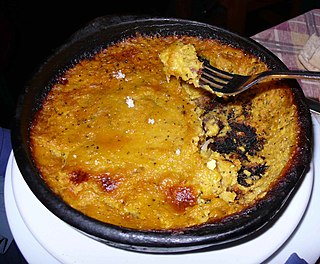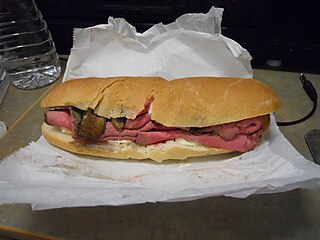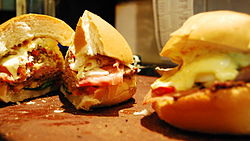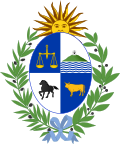
Argentine cuisine is described as a blending of cultures, from the Indigenous peoples of Argentina who focused on ingredients such as humita, potatoes, cassava, peppers, tomatoes, beans, and yerba mate, to Mediterranean influences brought by the Spanish during the colonial period. This led to cultural blending of criollos, Indigenous, and sub-Saharan African in the cuisine. Later, this was complemented by the significant influx of Italian and Spanish immigrants to Argentina during the 19th and 20th centuries, who incorporated plenty of their food customs and dishes such as pizzas, pasta and Spanish tortillas.

Tripe is a type of edible lining from the stomachs of various farm animals. Most tripe is from cattle, pigs and sheep.

Chorizo is a type of pork sausage originating from the Iberian Peninsula. It is made in many national and regional varieties in several countries on different continents. Some of these varieties are quite different from each other, occasionally leading to confusion or disagreements over the names and identities of the products in question.

Offal, also called variety meats, pluck or organ meats, is the internal organs of a butchered animal. The word does not refer to a particular list of edible organs, and these lists of organs vary with culture and region, but usually exclude skeletal muscle. Offal may also refer to the by-products of milled grains, such as corn or wheat.

Churrasco is the Portuguese and Spanish name for grilled beef prominent in the cuisines of Brazil, Uruguay, and Argentina. The term is used in other Spanish- and Portuguese-speaking countries for a variety of different meat products.

A schnitzel is a thin slice of meat. The meat is usually thinned by pounding with a meat tenderizer. Most commonly, the meat is breaded before frying. Breaded schnitzel is popular in many countries and is made using veal, pork, chicken, mutton, beef, or turkey. Schnitzel is very similar to the dish escalope in France and Spain, panado in Portugal, tonkatsu in Japan, cotoletta in Italy, kotlet schabowy in Poland, milanesa in Latin America, chuleta valluna in Colombia, and chicken-fried steak and pork tenderloin of the United States.

The milanesa is a variation of the Lombard veal Milanese, or the Austrian Wiener Schnitzel, where generic types of meat breaded cutlet preparations are known as a milanesa.

Farinata, socca, torta di ceci, or cecina is a type of thin, unleavened pancake or crêpe made from chickpea flour. It originated in Italy and later became a typical food of the Ligurian Sea coast, from Nice to Sardinia and Elba islands. It is also typical in Gibraltar, where it is called calentita.

Choripán is a type of sandwich with chorizo popular in Argentina, Chile, Uruguay, Paraguay, Peru, Bolivia and Venezuela. The name comes from the combination of the names of its ingredients: a grilled chorizo sausage and a crusty bread such as a pan batido, baguette, or francés.

Uruguayan cuisine is a fusion of cuisines from several European countries, especially of Mediterranean foods from Spain, Italy, Portugal and France. Other influences on the cuisine resulted from immigration from countries such as Germany and Scotland. Uruguayan gastronomy is a result of immigration, rather than local Amerindian cuisine, because of late-19th and early 20th century immigration waves of, mostly, Italians. Spanish influences are abundant: desserts like churros, flan, ensaimadas yoo (Catalan sweet bread), and alfajores were all brought from Spain. There are also all kinds of stews known as guisos or estofados, arroces, and fabada. All of the guisos and traditional pucheros (stews) are also of Spanish origin. Uruguayan preparations of fish, such as dried salt cod (bacalao), calamari, and octopus, originate from the Basque and Galician regions, and also Portugal. Due to its strong Italian tradition, all of the famous Italian pasta dishes are present in Uruguay including ravioli, lasagne, tortellini, fettuccine, and the traditional gnocchi. Although the pasta can be served with many sauces, there is one special sauce that was created by Uruguayans. Caruso sauce is a pasta sauce made from double cream, meat, onions, ham and mushrooms. It is very popular with sorrentinos and agnolotti. Additionally, there is Germanic influence in Uruguayan cuisine as well, particularly in sweet dishes. The pastries known as bizcochos are Germanic in origin: croissants, known as medialunas, are the most popular of these, and can be found in two varieties: butter- and lard-based. Also German in origin are the Berlinese known as bolas de fraile, and the rolls called piononos. The facturas were re-christened with local names given the difficult German phonology, and usually Uruguayanized by the addition of a dulce de leche filling. Even dishes like chucrut (sauerkraut) have also made it into mainstream Uruguayan dishes.

Chicken parmesan, or chicken parmigiana, is a dish that consists of breaded chicken breast covered in tomato sauce and mozzarella, parmesan, or provolone cheese. A quantity of ham or bacon is sometimes added.

Pastel de choclo is a South American dish made from sweetcorn or choclo. It is similar to the pastel de elote found in Mexican cuisine and to the English corn pudding. The filling usually contains ground beef, chicken, raisins, black olives, onions, or slices of hard boiled egg. It is traditional in the gastronomies of Argentina, Bolivia, Chile, Colombia, Ecuador, Paraguay, Peru, Uruguay.

The roast beef sandwich is a sandwich that is made out of sliced roast beef or sometimes beef loaf. It is sold at many diners in the United States, as well as fast food chains, such as Arby's, Rax Roast Beef, and Roy Rogers Restaurants. This style of sandwich often comes on a hamburger bun and may be topped with barbecue sauce and/or melted American cheese. The roast beef sandwich also commonly comprises bread, cold roast beef, lettuce, tomatoes, and mustard, although it would not be uncommon to find cheese, horseradish, fresh/powdered chili pepper and even in some cases red onion. Roast beef sandwiches may be served hot or cold, and are sometimes served open faced.

A cordon bleu or schnitzel cordon bleu is a dish of meat wrapped around cheese, then breaded and pan-fried or deep-fried.
The seco is a stew typical of Ecuadorian Cuisine. It can be made with any type of meat. According to an Ecuadorian popular etymology, the name of seco comes from the Península de Santa Elena in Ecuador, where at the beginning of the XX century a camp English did oil work in Ancón, when referring to the second course of food, in English "second", the Ecuadorians repeated deforming the word until they reached the current "seco", which has been widely disseminated, despite being a myth, since records of this dish have been found since 1820, almost a century before the English presence in the Santa Elena Peninsula. At that time, deer and Creole goats abounded. According to the Dictionary of Peruvianisms of the Peruvian Wings University, seco is a «stew of beef, kid or another animal, macerated in vinegar, which is served accompanied by rice and a sauce of ají, huacatay and cilantro”. Thus, its main characteristic is to marinate and cook the chosen meat with some type of sauce acid, such as chicha, beer, naranjilla or vinegar.

Arroz chaufa, also known as arroz de chaufa, is a fried rice dish from Peru. It is part of the Chinese Peruvian cuisine, which is called chifa.

Breaded cutlet or braised cutlet is a dish made from coating a cutlet of meat with breading or batter and either frying or baking it.

The milanesa sandwich is a type of sandwich eaten in Argentina and Uruguay. The bread is usually a white baton or short baguette type, cut in half and filled with a large (beef) schnitzel, “milanesa” being the name schnitzels have in the region, plus sliced tomato, lettuce. It might also include other ingredients, such as sliced onions, ham, cheese and egg. The "milanesa de pollo" variant replaces the beef schnitzel with breaded poultry. “Milanesa de pollo” is the same as a chicken escalope sandwich in Britain.





















